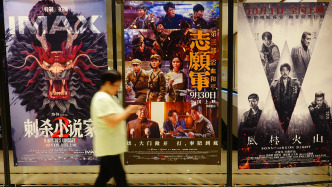
During the National Day holiday, many families opted for a trip to the cinema for a feast of light and film. According to real-time data from Lighthouse Professional Edition, as of 12:05 PM on October 7, the total box office (including pre-sales) for this year's National Day holiday (October 1 to 8) had exceeded 1.6 billion yuan.
This year's National Day film season maintained a high standard in terms of genre diversity and overall quality, with a diverse range of films competing across fantasy, action, war, drama, animation, history, and comedy, catering to audiences of all ages and preferences. "Volunteers: Bloody Peace" enjoyed a solid audience base, and its strong market performance provided significant support for the overall stable box office performance. In recent years, mainstream themes, exemplified by the "Volunteers" trilogy, have successfully pioneered the commercial genre film model of "national narratives," closely interweaving the grandeur of national history with the vivid destinies of individuals. Using sophisticated production techniques and moving emotional core, these films have been both highly entertaining and in line with mainstream values, achieving both economic and social benefits.
Beyond the silver screen, a "two-way journey" between a film and a city is unfolding across the country. Visiting film and television locations and "traveling with the movies" have become popular holiday destinations for many tourists. Chongqing, as one of the filming locations for the hit film "Assassination of Novelist 2," has become a popular cultural and tourism destination this holiday season. The film's alternate-dimensional world, "City in the Clouds," draws inspiration from Hongyadong, one of Chongqing's most iconic landmarks. Beijing tourist Chen Xi traveled to Chongqing specifically to capture the same scenery from the film. "The unique character of the 'mountain city' perfectly aligns with the film's fantastical atmosphere," she said. "After watching the film, I was able to fully appreciate Chongqing's three-dimensional and fantastical urban charm."
The film "A Wandering Life" was primarily filmed in Quanzhou, Fujian. The film features fishing ports, ancient villages, and coastlines in Jinjiang, Shishi, and other locations, each frame vividly capturing Quanzhou's maritime culture and cultural heritage. Riding on the film's popularity, many viewers visited Quanzhou during the National Day holiday to experience the city's unique charm. From a hit to a popular tourist destination, the story of light and shadow on the big screen has injected vibrant vitality into the cultural tourism market.
"Film + Cultural Tourism" isn't a simple addition; it aims to achieve win-win outcomes for all industries through the exploration and innovative expression of cultural connotations. On the eve of National Day, an art festival integrating film, markets, and youth culture was held in Hangzhou, Zhejiang. Each stall was named after a film, allowing visitors to browse, play, photograph, and shop in one place, experiencing scenes reminiscent of the movies and unlocking the same food, clothing, and cultural products as those featured in the films. Film has become a new engine driving consumption and economic growth.
In the past, movie tickets were simply credentials for a cultural experience, but now they've become a consumer pass connecting "food, accommodation, transportation, travel, shopping, and entertainment." Zhejiang Province is using movie tickets as a medium to connect scenic beauty with delicious food, extending the consumption chain. Some cinemas in Jiangsu Province have launched "Movies + Folk Music Performances" and "Movies + Intangible Cultural Heritage Cuisine" promotions, achieving a "win-win-win" scenario: theaters gain popularity, intangible cultural heritage is passed on, and audiences benefit. Jilin Province has launched the "Follow the Movies, Travel" consumer voucher program, leveraging the province's cultural and tourism resources to create a festive feast for citizens and tourists that combines movie-watching, sightseeing, and consumption, extending movie-watching consumption into cultural and tourism experiences.
The ticket economy is not only a consumer frenzy but also a manifestation of deep industrial integration. Earlier this year, the General Office of the State Council issued the "Several Measures on Further Cultivating New Growth Points and Prospering Cultural and Tourism Consumption," proposing to deepen the "culture and tourism + various industries" and "various industries + culture and tourism" initiatives to enrich consumption formats and scenarios. This year, the National Film Administration and the Ministry of Commerce have jointly launched the "Follow Movies to Enjoy Food," "Follow Movies to Travel," and "China Film Consumption Year" campaigns, leveraging the positive role of film in boosting consumption. These policy measures are promoting the upgrading of "film +" consumption.
According to Rao Shuguang, president of the Chinese Society of Film Critics, the introduction of these policies and measures is promoting the integrated development of film and offline consumption, fostering more complex cultural consumption scenarios. With the emergence of more innovative models, the in-depth integration of film and cultural tourism will continue to inject lasting vitality into the consumer market.
Mao Yu, deputy director of the Film Bureau of the Publicity Department of the CPC Central Committee who is in charge of daily work, said that the film industry is transforming from a single box office economy to a diversified consumption ecology. It is necessary to explore the diversified development and new forms of expression of film IP, consolidate the important position of film in cultural consumption, and expand "movie +" consumption methods such as "traveling with movies" and "going to the market with movies" to all aspects of social life.